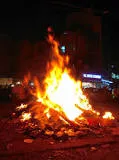Holi: The Festival of Colors and Joy
Holi, the most celebrated festival of India, is a vibrant and joyful celebration of a burst of colors, music, and dance. It is also known as the “Festival of Colors.” Holi marks the arrival of spring, the triumph of good over evil, and the festivals of life. It is a time when human beings come together to spread cheerfulness, pardon all the old grudges, and enjoy the festive atmosphere of bonding.
The History and Origins of Holi
Holi has its origins deeply rooted in Hindu mythology. One of the most commonly known tales of the festival is that of Hiranyakashipu, a demon king, and his son, Prahlad. Hiranyakashipu, having been given immortality, turned arrogant and ordered his subjects to worship only him. But his son, Prahlad, remained a devout follower of Lord Vishnu. Enraged at his son’s loyalty, Hiranyakashipu conspired with his sister Holika, who was immune to fire, to burn Prahlad alive by sitting on her lap in the midst of a bonfire. But when the flames hissed, Holika was burned, and Prahlad emerged unharmed, an embodiment of evil being vanquished by good.
The second story linked to Holi is the romantic pranksterism of Lord Krishna and Radha. Krishna, being a well-known prankster, would play pranks by throwing colors on Radha and her friends. This has become the reason for the tradition of throwing colors at each other during Holi.
Celebration and Traditions
Holi celebrations take place during the full moon day of the Hindu month of Phalguna (about March), and celebrations may continue for days. A night prior to Holi, during the full moon night, bonfires are set alight in a ritual called “Holika Dahan,” which marks the victory of good over evil. Family and communities gather around the fire and dance and sing, and there is a burning of effigies of Holika on occasions to mark the victory of good over evil.
There is laughter and glee on the streets on Holi day as people take to the streets to play with color powder (gulal). With water guns, pichkaris, and colored balloons, people chase each other around, squirting vibrant colors of pink, green, yellow, and blue. The festive atmosphere is accompanied with music, local folk songs, and dancing. Desserts such as gujiya (sweet-stuffed fried dumpling) and thandai (milk beverage flavored with cardamom and saffron) are shared among relatives and friends.
Cultural Significance
Beyond the playfulness and fun, Holi signifies something deeper. It is a spring festival of renewal and unfolding of life. Holi is an invitation to leave behind the bitter memories of past conflicts and embrace forgiveness and harmony. While playing with colors, the people celebrate the plurality of life and realize that in spite of difference in religion, caste, or ethnicity, there is oneness in the form of joy.
It is also the time to understand the cycle of life—evil and good, light and darkness, birth and death—and embrace the idea of change and transformation. Holi promotes bonding and communal spirit, as individuals from all sections of society come together to celebrate the festival.
Holi Around the World
Though Holi originated in India, it has now become extremely popular all over the globe, with people from all parts of the world celebrating the festival. It has become a global phenomenon from the United States of America to the United Kingdom, from Australia to South Africa. In certain communities, “Holi runs” and “festival of colors” are now common events where individuals of all colors unite and have fun playing with colors and music, typically as part of social functions or charity events.
While the spirit of Holi is never lost, each country gives their own flavor to the festival. In Nepal, for instance, Holi is known as Fagu and is celebrated similarly with the added feature of traditional dance forms. The festival in the United States and Europe has become a means of cultural exchange, with the big cities hosting large festivals.
Conclusion
Holi is far more than a mere throwing of colors—it is a festival of life, love, and the victory of good. Whether on the streets of Delhi, the shores of Goa, or a corner of the world, Holi unites people in a lovely burst of joy, music, and colors. It teaches us the strength of forgiveness, togetherness, and the beauty of accepting differences. Thus, this Holi let there be hues of colours dispersed with the spirit of peace, joy, and coming together!
If you’re interested in exploring the best smartphones available in the market, check out our list of the Best Phones Under 20,000 – March 2025 for top picks and detailed reviews!
